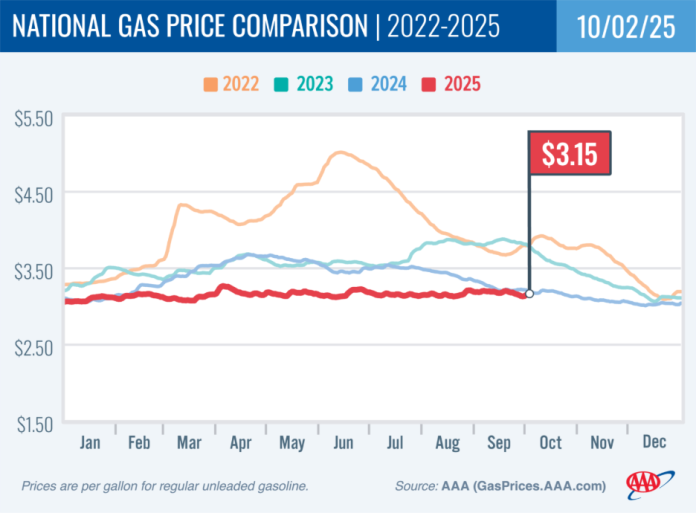As October unfolds, small business owners in the United States can breathe a sigh of relief as gas prices settle, offering some predictability in an otherwise fluctuating economic landscape. According to the American Automobile Association (AAA), the national average for a gallon of regular gasoline remains steady at $3.15, unchanged from last week, and slightly down from $3.19 a year ago. This stability could present both opportunities and challenges for local businesses that rely on fuel for their operations.
The current gas prices reflect seasonal patterns as demand drops and gas stations transition to winter-blend gasoline, which is less expensive to produce. There’s also good news on the crude oil front: OPEC+ is anticipated to announce an increase in production, further likely keeping prices favorable for consumers and businesses alike.
“For small businesses operating on thin margins, even slight fluctuations in fuel costs can have significant impacts,” said a spokesperson from AAA. This sentiment resonates with many entrepreneurs who rely on consistent fuel prices to manage budgets and operational expenses.
Right now, demand is decreasing, with the Energy Information Administration (EIA) reporting a drop from 8.95 million barrels per day to 8.51 million. This decrease is crucial, as it contributes to an increase in domestic gasoline supply, which rose from 216.6 million barrels to 220.7 million barrels last week. However, gasoline production did dip slightly, averaging 9.3 million barrels per day, signaling that while supply is up, there are ongoing factors that could affect future pricing.
A key takeaway for small business owners is the relationship between gas prices and operational costs. Companies dependent on vehicles for deliveries or services might see a more predictable budget during this time, allowing them to plan better. Conversely, those in states with high gas prices, such as California ($4.64 per gallon) and Washington ($4.53), may still feel the pinch. It’s essential for businesses to continuously monitor local gas market trends, especially if they have to navigate between different states with varying fuel costs.
Moreover, the EIA reports that U.S. crude oil inventories increased by 1.8 million barrels, though they remain about 4% below the five-year average for this time of year. This inventory status can have implications for future prices, as higher inventory usually signals increased supply and can lead to lower prices in the long term, easing operating costs for small businesses that rely on fuel.
Interestingly, electric vehicle (EV) charging prices remain stable at 36 cents per kilowatt hour nationwide. For businesses considering the shift to electric fleets, this stability offers a point of consideration. Companies can weigh the long-term savings potential of electric vehicles against the upfront costs, keeping an eye on operating costs as they explore sustainable options.
Additionally, businesses may want to consider how changing gas prices impact their supply chains. Local sourcing can mitigate the risks associated with fluctuating fuel prices, making regional suppliers more attractive as they could help in maintaining steady operational costs.
However, challenges remain. Seasonal maintenance on some U.S. refineries could lead to temporary supply constraints, and small business owners should prepare for potential price increases during these times. Monitoring supplier communications and market updates will be crucial.
Drivers can easily stay informed about current gas prices, as well as electric charging rates, through resources like the AAA TripTik Travel Planner, which helps find the best routes while offering up-to-date pricing information. This can be a vital tool for small businesses planning customer deliveries or team travel.
As the month progresses, understanding the dynamics at play in the fuel market can equip small business owners with insights to navigate their operational strategies effectively. By staying informed and flexible, they can leverage the current stability to their advantage, ensuring they can continue to serve their customers efficiently without undue financial strain.
For more detailed information, visit the AAA’s official post on this topic here.
Image Via Gas Price



